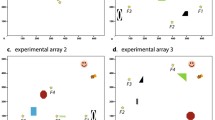Abstract
Social insect foragers have to make foraging decisions based on information that may come from two different sources: information learned and memorised through their own experience (“internal” information) and information communicated by nest mates or directly obtained from their environment (“external” information). The role of these sources of information in decision-making by foragers was studied observationally and experimentally in stingless bees of the genus Melipona. Once a Melipona forager had started its food-collecting career, its decisions to initiate, continue or stop its daily collecting activity were mainly based upon previous experience (activity on previous days, the time at which foraging was initiated the day(s) before, and, during the day, the success of the last foraging flights) and mediated through direct interaction with the food source (load size harvested and time to collect a load). External information provided by returning foragers advanced the start of foraging of experienced bees. Most inexperienced bees initiated their foraging day after successful foragers had returned to the hive. The start of foraging by other inexperienced bees was stimulated by high waste-removal activity of nest mates. By experimentally controlling the entries of foragers (hence external information input) it was shown that very low levels of external information input had large effect on the departure of experienced foragers. After the return of a single successful forager, or five foragers together, the rate of forager exits increased dramatically for 15 min. Only the first and second entry events had large effect; later entries influenced forager exit patterns only slightly. The results show that Melipona foragers make decisions based upon their own experience and that communication stimulates these foragers if it concerns the previously visited source. We discuss the organisation of individual foraging in Melipona and Apis mellifera and are led to the conclusion that these species behave very similarly and that an information-integration model (derived from Fig. 1) could be a starting point for future research on social insect foraging.
Similar content being viewed by others
Author information
Authors and Affiliations
Additional information
Received: 16 April 1997 / Accepted after revision: 30 August 1997
Rights and permissions
About this article
Cite this article
Biesmeijer, J., van Nieuwstadt, M., Lukács, S. et al. The role of internal and external information in foraging decisions of Melipona workers (Hymenoptera: Meliponinae). Behav Ecol Sociobiol 42, 107–116 (1998). https://doi.org/10.1007/s002650050418
Issue Date:
DOI: https://doi.org/10.1007/s002650050418




